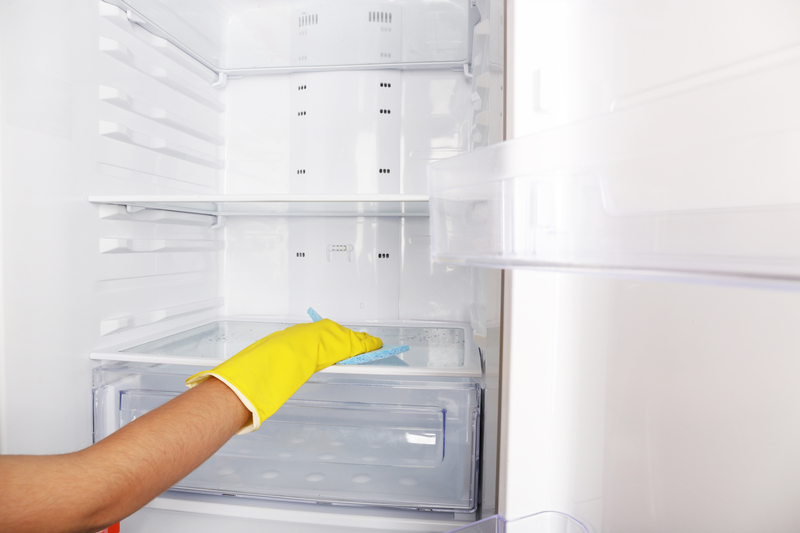Mastering the Art of Curtain Cleaning: Tips for a Fresh Look
Posted on 30/06/2025
Mastering the Art of Curtain Cleaning: Tips for a Fresh Look
Curtains play a vital role in our homes, offering not only privacy but also a touch of elegance and warmth. However, curtains often become magnets for dust, pet hair, pollen, and even odors, making regular maintenance necessary. If you wish to enhance the lifespan and beauty of your drapes, understanding the art of curtain cleaning is crucial. In this comprehensive guide, we will delve into the best tips, techniques, and expert secrets to keep your window coverings looking fresh and beautiful all year round.
Why Curtain Cleaning Matters
Many people overlook cleaning curtains regularly, assuming vacuuming floors and wiping surfaces are enough. Yet, unwashed curtains can harbor allergens, dust mites, and bacteria, impacting indoor air quality and compromising your family's health. Plus, dirty curtains lose their charm, color, and appeal, affecting the overall ambiance of your interiors.
Benefits of Regular Curtain Cleaning
- Enhanced Room Aesthetics: Clean curtains brighten up any room and contribute to an overall neat appearance.
- Allergy Reduction: Regular cleaning removes allergens and dust, making the air in your home healthier to breathe.
- Increased Lifespan: Proper maintenance can extend the longevity of your window treatments by protecting delicate fibers.
- Odor Elimination: Washing and airing out removes stale odors, smoke, and cooking smells locked in fabric.

Types of Curtains and Cleaning Methods
Not all curtains are created equal. The right curtain cleaning method depends greatly on the type of fabric, lining, and construction. Understanding your curtains' material is the first step in mastering curtain maintenance.
Common Curtain Fabrics
- Cotton Curtains: Durable and easy to wash, but may shrink if cleaned improperly.
- Linen Curtains: Natural and elegant, requiring gentle care to avoid wrinkles and damage.
- Velvet Curtains: Luxurious but delicate, often needing professional dry cleaning.
- Silk Curtains: Sophisticated, extremely fragile, and best handled with specialist cleaning.
- Polyester Curtains: Stain-resistant, typically machine washable.
- Sheer Curtains: Lightweight, demand careful hand washing or gentle machine cycles.
How to Identify Washing Instructions
Always check the manufacturer's care label sewn into the seam of your curtain panel. This label offers crucial guidance, spelling out whether your curtain is machine washable, suitable for dry cleaning, or requires hand washing. If there's no label, test a small hidden area first with mild detergent and water.
Step-by-Step: General Curtain Cleaning Process
Before You Start
- Read care labels and gather supplies.
- Remove hooks, rings, or tie-backs.
- Shake outside to eliminate loose dust.
- Perform a spot test for colorfastness with a mild detergent.
1. Vacuum Curtains Regularly
The first line of defense against dust and dirt is vacuuming your curtains every few weeks. Use your vacuum's upholstery attachment with the brush setting. Start from the top and work your way down, being gentle around delicate trims and embellishments.
2. Steam Cleaning for a Deep Refresh
Steam cleaning is a great way to sanitize and deodorize heavy drapes without having to remove them. Use a handheld garment steamer or upholstery steam cleaner. Carefully run the steamer down the length of the curtain, keeping it several inches from the fabric to avoid dampening it too intensely.
3. Machine Washing
Many modern curtains, especially those made from cotton, polyester, or blends, can be machine washed:
- Use a gentle cycle and cold water to prevent fading and shrinking.
- Select a mild laundry detergent with no bleach or harsh chemicals.
- Remove and hang the curtains to air dry immediately after the cycle ends.
- Iron on a low setting if necessary, avoiding direct contact with the surface for delicate materials.
4. Hand Washing
For delicate fabrics such as silk, lace, or sheers, choose to hand wash:
- Fill a bathtub or large sink with cold or lukewarm water and a small amount of mild detergent.
- Gently agitate the curtains without rubbing or wringing.
- Drain dirty water and refill with clean water to rinse thoroughly.
- Press out excess water carefully, then lay flat on towels or hang to dry away from direct sunlight.
5. Dry Cleaning
Some curtain materials, especially velvet and lined fabrics, cannot be safely washed at home. Professional dry cleaning ensures thorough cleaning without risk of shrinking, warping, or color bleeding. Ask your cleaner if they offer pickup and drop-off services for extra convenience.
Special Tips for a Fresh Curtain Look
How to Remove Stubborn Stains
Act fast on spills and stains! Gently blot the stain with a clean cloth, avoiding harsh rubbing which can damage fibers. For greasy marks, sprinkle baking soda to absorb the oil, then vacuum and spot-clean. For stubborn spots, use a gentle stain remover approved for your curtain's material, and always test on a hidden corner first.
How to Deodorize Curtains
- Natural Freshness: Hang curtains outside in fresh air on breezy days to eliminate stale odors.
- Baking Soda Mist: Lightly sprinkle baking soda, leave for an hour, then shake or vacuum off.
- Mix your own spray: Fill a spray bottle with equal parts water and white vinegar. Mist lightly, avoiding oversaturation.
Ironing and Steaming for a Crisp Look
Curtain wrinkles can ruin even the cleanest appearance. Iron curtains on the reverse side using the fabric's recommended setting or use a garment steamer for larger panels. Hang curtains while still slightly damp, if possible, to prevent stubborn creases from setting.
Prolonging Curtain Cleanliness Between Washes
- Vacuum Frequently: Doing this reduces dust and allergen buildup.
- Keep windows closed: Especially during high pollen seasons or windy days to prevent extra dust accumulation.
- Avoid direct sunlight: Excessive light can fade colors and weaken fabrics. Use blinds if possible.
- Launder or vacuum tiebacks and valances regularly as well.
- Don't let pets rest on window sills covered by curtains - their fur and dander cling to fabrics.
When to Replace Your Curtains
Even with the best curtain cleaning routines, no fabric lasts forever. Replace curtains when:
- Colors are faded beyond revival.
- Stains or mildew remain after thorough cleaning.
- Fabric is torn, shredded, or noticeably weak.
Eco-Friendly Curtain Cleaning Tips
Today, many homeowners embrace eco-friendly curtain cleaning. Not only does this protect your family, but it also safeguards the planet. Here's how:
- Choose biodegradable detergents and avoid unnecessary chemicals.
- Air dry instead of tumble drying to save energy and prevent shrinkage.
- Steam clean using only water to freshen up most curtain fabrics.
- Upcycle old curtains as rags or for craft projects, minimizing waste.
Professional Curtain Cleaning: When and Why
While home cleaning is effective for most fabrics, there are times when you should turn to a professional curtain cleaner:
- Your curtain fabric is labeled "dry clean only."
- The drapes are lined, have delicate embellishments, or are made from velvet or silk.
- You're dealing with severe staining or smoke damage.
- You lack the time or equipment for large or heavy curtains.
Professional services use advanced techniques and equipment, ensuring protection and restoration for your precious curtains. Many even offer in-situ cleaning, so you don't need to uninstall bulky or elaborate window dressings.
DIY Natural Curtain Cleaning Recipes
1. Simple Fabric Cleaner
- 2 cups lukewarm water
- 1 teaspoon mild liquid soap
- 1 tablespoon white vinegar
Mix in a spray bottle, mist lightly on fabric, and wipe gently with a soft cloth.
2. Baking Soda Deodorizer
- 1/4 cup baking soda
- 10 drops of essential oil (such as lavender or lemon)
Sprinkle on curtains, allow to sit, then vacuum after an hour for a fresher scent.
3. Spot Stain Remover
- Mix 1 tablespoon baking soda with 2 tablespoons water to form a paste.
Apply to stain, let sit for 15 minutes, then blot with a damp cloth. Always test on an inconspicuous area.

FAQs About Curtain Cleaning
How often should I clean curtains?
Ideally, vacuum curtains once a week and do a deep clean (washing or steam cleaning) every 3-6 months, depending on environmental factors and allergies.
Can I machine wash sheer or delicate curtains?
Yes, but use a mesh laundry bag, set a delicate cycle, and avoid spinning or wringing. Air dry immediately.
Is it safe to bleach white curtains?
Bleaching is often too harsh, especially for natural fibers. Opt for baking soda or white vinegar for brightening instead.
How do I remove mildew from curtains?
Brush off loose spores outdoors. Treat the spot with a solution of one part white vinegar to one part water, blot, then wash as usual.
Conclusion: Achieve a Consistently Fresh Curtain Look
Mastering the art of curtain cleaning ensures that your living space remains fresh, healthy, and visually stunning. By understanding your curtain types, using the best cleaning practices, and maintaining a routine, you'll guarantee lasting beauty and hygiene for all your window treatments. Whether you're tackling dust, stains, or everyday odors, implement these strategies for drapes that always make your home shine.
Invest a little time in proper curtain care, and the rewards - from brighter rooms to improved indoor air - will be obvious to all who visit your home.




